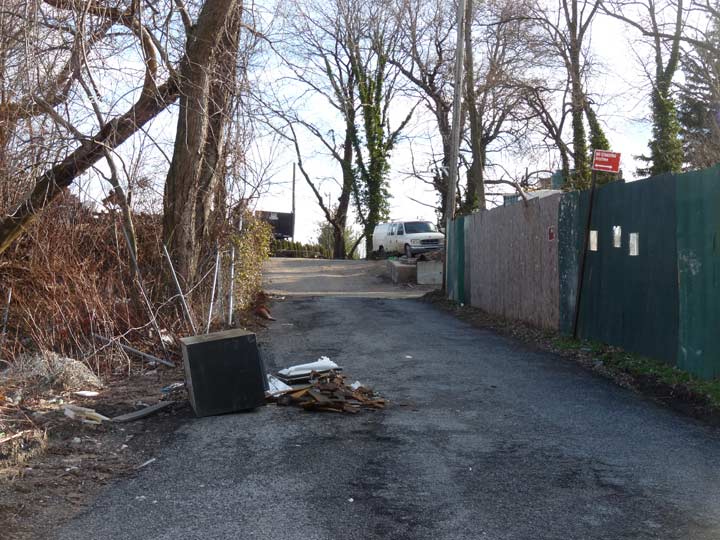No, Wiman Place doesn’t look like much to write home to Mother about. It’s a two-bock, rubble-strewn alley tucked behind the historic St. Mary’s Church on Bay Street in Rosebank. Along with the somewhat lengthier Wiman Avenue in Great Kills and Erastina Place in Mariners Harbor, it commemorates Erastus Wiman, who helped bring railroads to Staten Island.
Non-residents of Staten Island may not know that the borough has its very own rail line which, although resembling a subway, isn’t run as a subway at all. Formerly known as Staten Island Rapid Transit, the Staten Island Railway was begun by Cornelius Vanderbilt in 1851 for the purposes of linking Vanderbilt’s Landing in Stapleton to Clifton. By 1860, the line was extended to Eltingville, then on to Annadale, and finally to Tottenville.
In 1883, Erastus Wiman, in partnership with the Baltimore & Ohio Railroad, built a line to South Beach and along the North Shore. By 1885, what would become the SIRT was complete, with the completion of the tunnel between Stapleton and the St. George Ferry. The ferry terminal opened in 1897 (the present-day terminal was constructed in 1951 after the original was destroyed in a fire in 1946).
By 1953, ridership had dropped to such a degree (due to reduced bus fares) that the B&O threatened to terminate all passenger service. The City agreed to subsidize service on the Tottenville line and terminate service on the North Shore and South Beach branches. The B&O ended its involvement with Staten Island Rapid Transit in 1971, selling it to NYC for $3.5 million. Quaint B&O passenger coaches that had operated on the line since 1925 were replaced by modern R-44 subway cars. Finally, the MTA changed the name of the SIRT in 1994, renaming it the Staten Island Railway.
Check out the ForgottenBook, take a look at the gift shop, and as always, “comment…as you see fit.”
2/11/19


7 comments
Erastus is one of those given names that’s so completely out of fashion it’s due for a revival. It’s sort of tough sounding too, so there wouldn’t be a Boy Named Sue effect.
Erastus WIman (1834-1904) is indeed a significant, if forgotten figure in the history of Staten Island transportation. Much like his namesake street, he died in relative poverty after amassing a fortune in business ventures. Born in Canada, he came to New York around 1867 and settled on Staten Island. Here’s a link to an article from the Staten Island Advance around 2012 that gives more details about his interesting life: https://www.silive.com/specialreports/2011/03/for_erastus_wiman_st_george_wa.html
It’s also worth noting that reduced bus fares helped torpedo Staten Island Railway ridership after World War II, but there’s more to the story. In February 1947 Staten Island’s private bus operator, Isle Transportation Corp., abruptly stopped running, forcing the NYC Board of Transportation to step in and operate the service. Unlike the rest of the city, Staten Island bus fares were distance-based, ranging from five to twenty cents, increasing as a rider traversed up to four zones. When subway and bus/trolley fares were increased in 1948, many Staten Island riders enjoyed a fare decrease, as a flat seven-cent fares went into effect on its routes. Included was a combination fare of twelve cents if a bus rider continued or began his/her journey on the subway in Manhattan (the ferry crossing was still another nickel). But the net effect on the SI Railway was a severe hemorrhaging of ridership, from over 14 million annually in 1945 to about 4 million in 1951.
The trestle connections are still there to the New Jersey, but the tracks were removed. It’s a shame.
The tracks were not removed, and the Arthur Kill railroad bridge is still an active crossing for freight trains to/from New Jersey.
The tracks were not removed on the bridge, they were abandoned from the 1990s to 2006 when freight service was restored between Howland Hook Container Terminal and the rest of the national rail network.
S.I. Comment: You said that you are looking for cobble stone streets. I posted on the S.I. facebook site. There are evidently few left. All short sections. Stone St. and VanDuzer St. Stapleton. Also a short street off Snug Harbor Rd. off the curve near Richmond Terr. There may be more but I have to rely on people that still live on S.I.
how about a map?